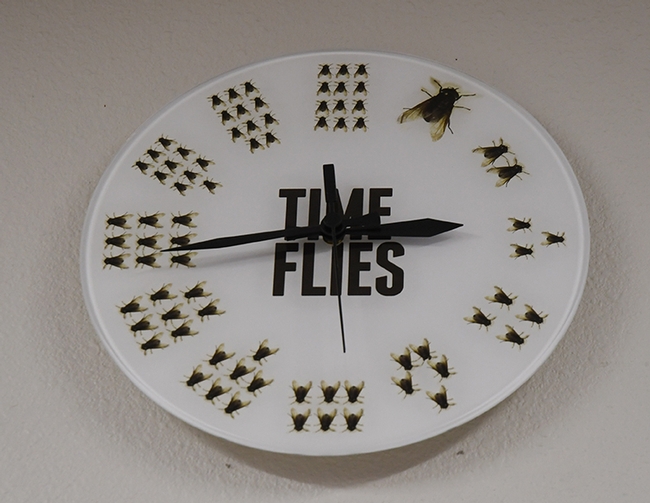
For three hours, six UC Davis doctoral students discussed their research and fielded questions from the 270-plus guests, ranging from pre-kindergarten students to senior citizens. The event, free and family friendly, followed the theme, "Time Flies When You Are Studying Insects: Cutting Edge Student Research."
Doctoral students who showcased their research were:
- Entomologist Yao Cai of the Joanna Chiu lab, UC Davis Department of Entomology and Nematology.
Cai, a fourth-year doctoral student, studies circadian clock in insects. “Using Drosophila melanogaster (fruit fly) and Danaus plexippus (monarch butterfly), as models, we seek to understand how these insects receive environmental time cues and tell time, how they organize their daily rhythms in physiology and behavior, such as feeding, sleep and migration (in monarch butterfly),” he said. Assisting him were Nitrol Liu, a graduate student in the Chiu lab, and associate Ben Kunimoto, a Davis Senior High School student. - Entomologist Charlotte Herbert Alberts, who studies assassin flies (also known as robber flies) with major professor Lynn Kimsey, director of the Bohart Museum of Entomology and professor of entomology.
“Assassin flies are voracious predators on other insects and are able to overcome prey much larger than themselves,” said Alberts, a fifth-year doctoral student. “Both adult and larval assassin flies are venomous. Their venom consists of neurotoxins that paralyze their prey, and digestive enzymes that allow assassin flies to consume their prey in a liquid form. These flies are incredibly diverse, ranging in size from 5-60mm, and can be found all over the world! With over 7,500 species, Asilidae is the third most specious family of flies. Despite assassin flies being very common, most people do not even know of their existence. This may be due to their impressive ability to mimic other insects, mainly wasps, and bees.” - Entomologist-ant specialist Zachary Griebenow of the Phil Ward lab, UC Davis Department of Entomology and Nematology.
Griebenow, a third-year doctoral student, showed specimens of the ant subfamily Leptanillinae, most of them male. He emphasized the great morphological diversity observed in males and talked about his systematic revision of the subfamily. In particular, he explained "how the study of an extremely obscure group of ants can help us understand the process of evolution that has given rise to all organisms." - Forest entomologist Crystal Homicz, who studies with Joanna Chiu and research forest entomologist Chris Fettig, Pacific Southwest Research Station, USDA Forest Service, Davis. (She formerly studied with the late Steve Seybold of USDA Forest Service and the Department of Entomology and Nematology.)
"Bark beetles are an incredibly important feature of forests, especially as disturbance agents," said Homicz, a first-year doctoral student. Her research focuses on how bark beetles and fire interact, "given that these are the two most important disturbance agents of the Sierra Nevada." She discussed how the interaction between bark beetles and fire, why bark beetles and fire are important feature of our forest ecosystem. She also discussed more generally "the importance of bark beetles in many forest systems throughout North America." Assisting at her table: Gabe Foote, a new first-year doctoral student in forest entomology. - Forensic entomologist Alexander Dedmon, who studies with Robert Kimsey, UC Davis Department of Entomology and Nematology.
"My research focuses on insect succession," said Dedmon, a fifth-year doctoral student. "In forensic entomology, succession uses the patterns of insects that come and go from a body. These patterns help us estimate how long a person has been dead." Visitors learned about "the many different ways insects can be used as evidence, and what that evidence tells us." - Ecologist Ann Holmes, affiliated with the Graduate Group in Ecology, Department of Animal Science, and the Genomic Variation Laboratory, studies with major professors Andrea Schreier and Mandi Finger.
Holmes, a fourth-year doctoral student, talked about her research project that looks at insects eaten by bats in the Yolo Bypass. "The insects eat crops such as rice, so bats provide a valuable service to farmers," she explained. "Hungry bats can eat as much as their own body weight in insects each night." Visitors learned how DNA is used to detect insects in bat guano (poop). "Insects in bat poop are hard to identify because they have been digested, but I can use DNA to determine which insects are there. We care about which insects bats eat because bats are natural pest controllers. With plenty of bats we can use less pesticide on farms and less mosquito repellent on ourselves."
Entomologist Jeff Smith, curator of the Lepidoptera (butterflies and moths) section, and Bohart associate and naturalist Greg Kareofelas showed part of the Lepidoptera collection, which totals nearly 500,000 specimens. UC Davis entomologist graduate Ann Kau staffed the craft activity table--rock painting. The rocks, mostly insect-themed, will be hidden on campus. Undergraduate student Ian Clark displayed the critters in the live "petting zoo," including Madagascar hissing cockroaches, walking sticks and tarantulas. (Photos in the next Bug Squad blog). Tabatha Yang, education and outreach coordinator, organized a scavenger hunt featuring questions and clues about insects.
The Bohart Museum, directed by entomology professor Lynn Kimsey and founded by noted entomologist Richard M. Bohart (1913-2007), houses a global collection of nearly eight million specimens. It is also the home of the seventh largest insect collection in North America, and the California Insect Survey, a storehouse of insect biodiversity.
The insect museum is open to the public Mondays through Thursdays from 9 a.m. to noon and 1 to 5 p.m., except on holidays. More information on the Bohart Museum is available on the website at http://bohart.ucdavis.edu or by contacting (530) 752-0493 or bmuseum@ucdavis.edu.
Meanwhile, UC Davis is gearing up for its ninth annual Biodiversity Museum Day on Saturday, Feb. 15, featuring 13 museums or collections. Free and family friendly, the event is a science-based day at which visitors of all ages can meet and talk with UC Davis scientists—from undergraduates to staff to emeriti professors, coordinator Tabatha Yang of the Bohart Museum said.
Attached Images:
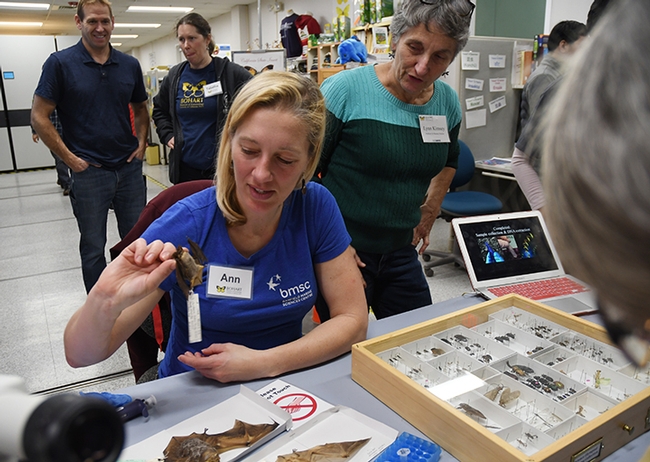
Doctoral student Ann Holmes holds up a bat specimen. Next to her is Lynn Kimsey, director of the Bohart Museum and professor of entomology at UC Davis. (Photo by Kathy Keatley Garvey)
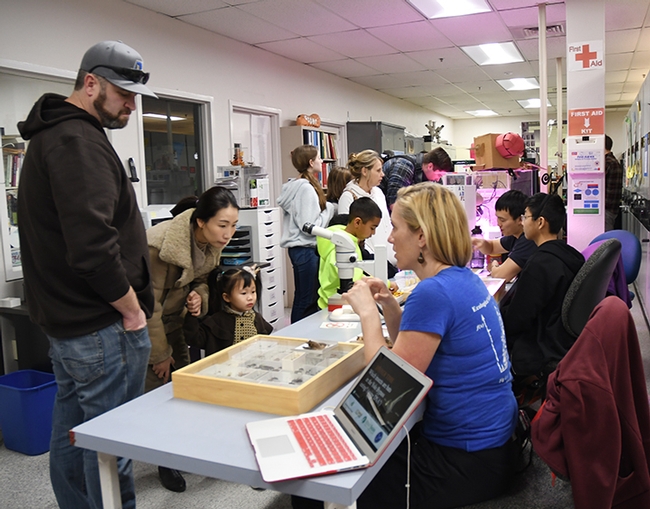
Visitors flock around doctoral student Ann Holmes to see the bat specimens and ask questions. (Photo by Kathy Keatley Garvey)
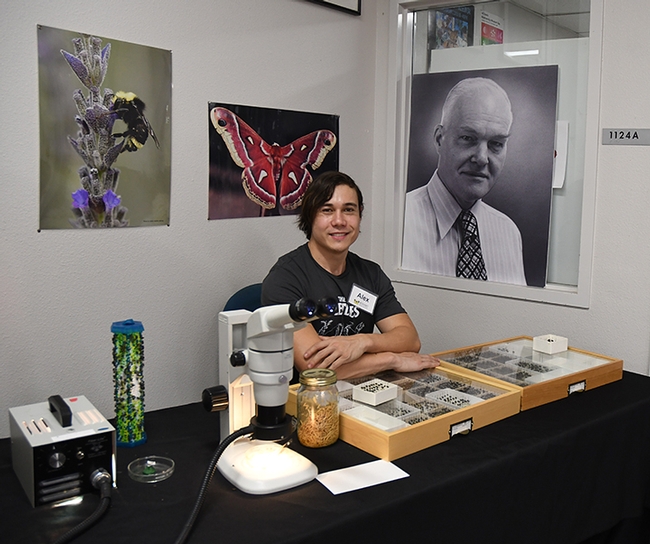
Forensic entomologist and doctoral student Alexander Dedmon awaits visitors. Behind him is a portrait of Professor Richard Bohart (1913-2007), founder of the Bohart Museum of Entomology. (Photo by Kathy Keatley Garvey)
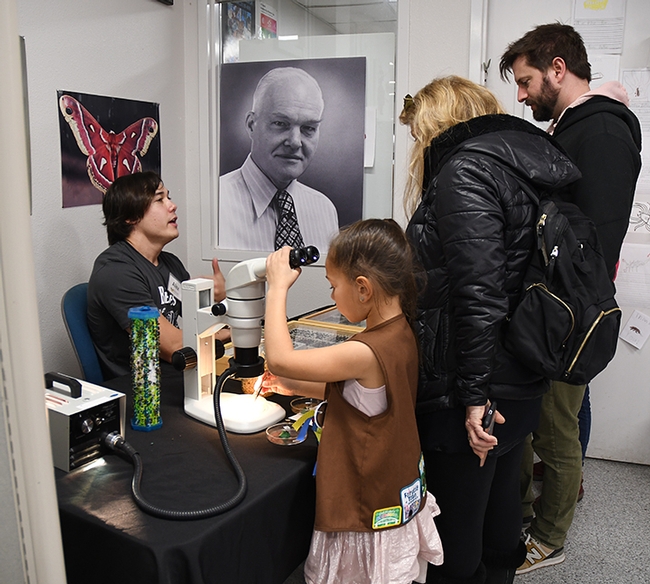
Forensic entomologist Alexander Dedmon answers questions about the many different ways insects can be used as evidence in forensic entomology.
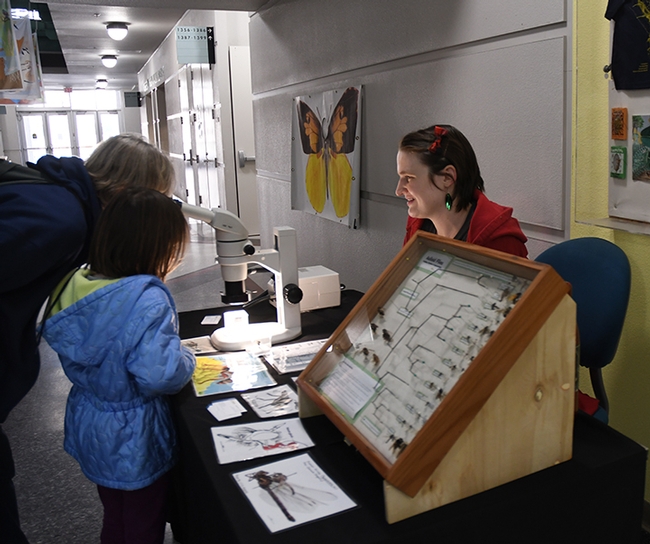
Doctoral student Charlotte Alberts explains her research on assassin flies, also known as robber flies. (Photo by Kathy Keatley Garvey)
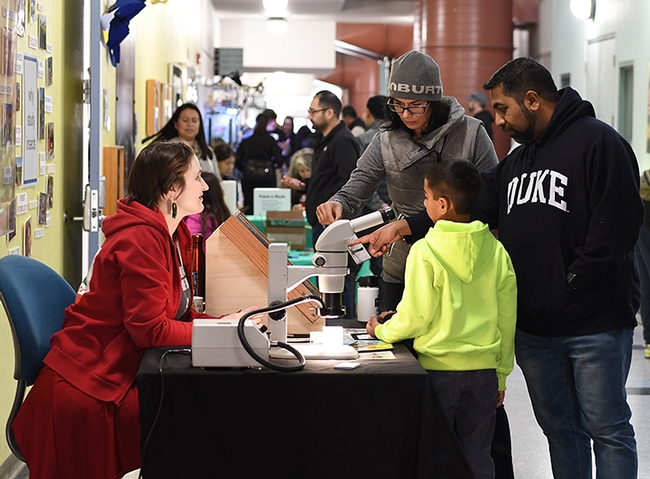
Visitors learned from doctoral student Charlotte Alberts how assassin flies catch their prey. (Photo by Kathy Keatley Garvey)
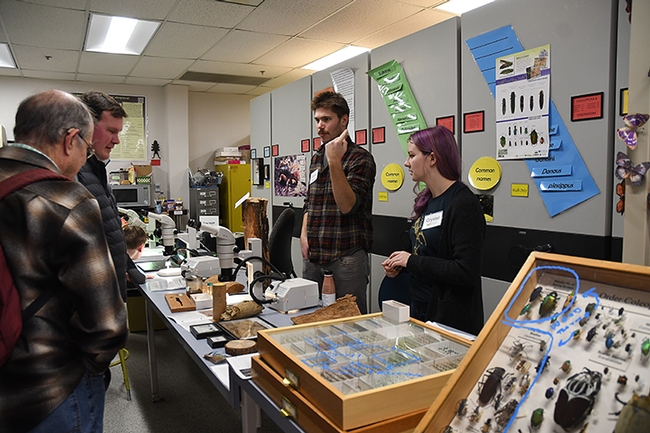
Forest entomologists and doctoral students Gabe Foote (left) and Crystal Homicz (right) talk about their research. (Photo by Kathy Keatley Garvey)
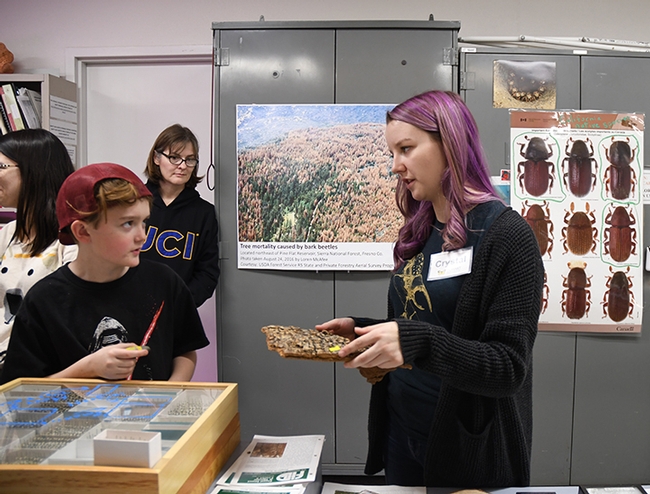
Forest entomologist Crystal Homicz shows visitors evidence of damage by forest beetles. (Photo by Kathy Keatley Garvey)
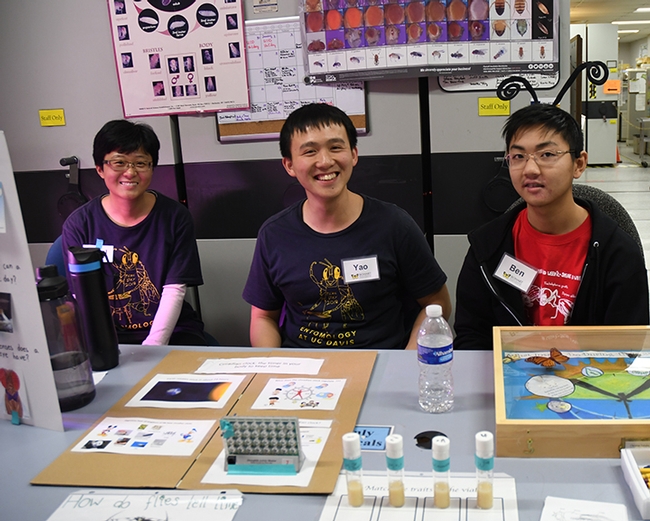
Doctoral student Yao Cai (center) led the discussion on circadian clocks and insects. With him are Nitrol Liu (left), also a graduate student in the Chiu lab, and Ben Kunimoto, a Davis Senior High School student. (Photo by Kathy Keatley Garvey)
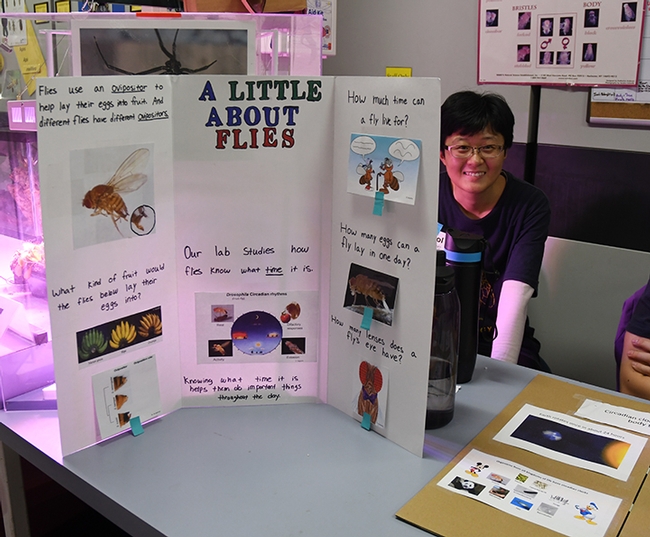
Graduate student Nitrol Liu of the Joanna Chiu lab shows a fruit fly poster. (Photo by Kathy Keatley Garvey)
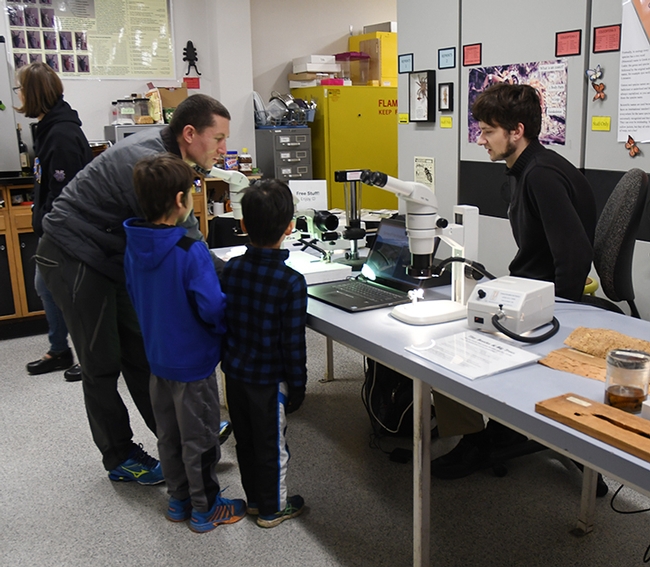
Doctoral student Zachary Griebenow greets visitors eager to learn about ants. (Photo by Kathy Keatley Garvey)
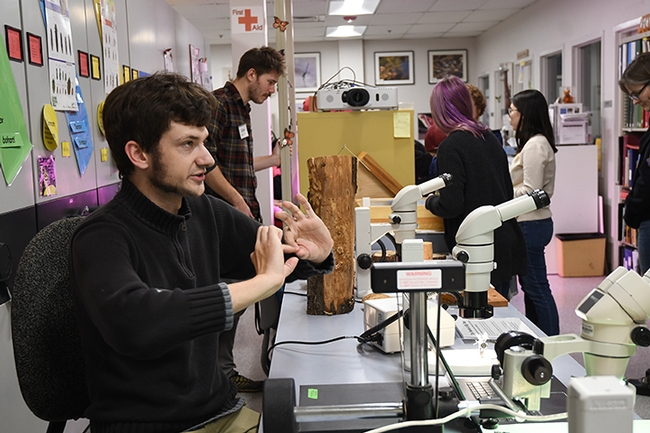
Doctoral student Zachary Griebenow talks about his specialty, ants. (Photo by Kathy Keatley Garvey)